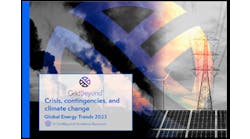In the old days, the grid was uni-directional. But now, it’s a multi-directional grid with more and more energy storage, renewables, electric vehicles and other resources coming online, and the utility’s task has become complex — to say the least.
The utility of the future — under New York State’s Reforming the Energy Vision (REV) and elsewhere — has a lot of challenges on its hands, says Brad Harkavy, General Manager, LiveData Utilities, which provides operational intelligence data integration for the smart grid.
“As you move toward distributed energy, it’s more complicated to control the grid,” he says. “Before, there were unidirectional sources; now it’s a multi-directional system. Trying to manage that is hard.”
For example, by 2020, half of California’s energy is expected to come from renewable resources.
“If all those resources are solar, and a cloud goes by, you’d lose 50 perfect of the energy in seconds,” he says. In this situation, systems are needed to quickly locate, dispatch and prioritize the additional resources available, whether they’re wind power plants, microgrids, energy storage or fossil fuel plants.
What’s more, some of the resources on the grid are brand new, while others are very old.
“When integrating into the grid, you’re running the spectrum of old ancient equipment that needs to be integrated and controlled safely to the most modern devices,” he explains.
In addition, the grid’s communications abilities vary from place to place.
“The connectivity spans from great to horrible,” says Harkavy. “Parts of the electric grid are still being controlled with dial-up connections or very old radio-based networks. Connections go down because the cell tower goes down or the quality of a public radio network is not always consistent; sometimes it’s great, sometimes horrible, and you have to work in an environment where whatever your control mechanisms are can be adept at managing it.”
Energy storage more complex
While it’s complicated to manage generation resources, it’s even more complicated to manage grid-scale storage resources on demand, says Harkavy. Sometimes grid-scale storage has to be brought online quickly to balance out load.
“The expectation is to turn them off and on very quickly,” which isn’t always easy, he says.
But that’s not all. Safety issues come into play when integrating all these resources onto the grid. If there’s an outage and a lineman comes to a neighborhood where a wind turbine is still spinning, and the lineman thinks the wind turbine is off, it’s a big safety issue; the lineman could die, he explains.
“You have to switch things on and off in ways that are controlled so what you say you’re going to do will actually happen.”
To help solve these many challenges, LiveData Utilities has partnered with Space-Time Insight. The companies are collaborating to develop services and solutions for electric utilities moving toward the utility of the future. LiveData Utilities specializes in operational intelligence data integration for the smart grid. and Space-Time Insight provides situational intelligence software for asset-intensive industries.
“Space-Time Insight makes decisions, and we provide the system that makes it happen efficiently,” says Harkavy.
For example, a windmill generates electricity and has control mechanisms on it. “In a simple world, you’d take the ethernet cable, plug it in and be able to talk to it.”
But in reality, systems are needed to manage and prioritize dispatch of all the distributed energy resources. “You need something like traffic police standing in the intersection; this lane has to slow down and this has to accelerate because there’s an ambulance coming through.”
“You need something like traffic police standing in the intersection; this lane has to slow down and this has to accelerate because there’s an ambulance coming through.”
“Our systems are capable of collecting data, integrating it, and spitting it out in a form that’s easily digestible for someone with a strong analytics engine like Space-Time Insight,” he says. “We provide a middle layer of software that routes and filters data.”
For example, if a cell tower goes down, the LiveData Utilities software finds redundant systems or communicates that it has lost communication with a wind turbine or other resources and something needs to be done, he explains.
Space-Time Insight’s real-time visual analytics, on the other hand, illuminates “the what, where, when, why and how of every asset and situation. Distribution intelligence correlates, analyzes and visualizes multiple disparate sources of data related to distribution and distributed energy resources,” says Suresh Karri, director, product management-utilities for Space-Time Insight. The company’s analytics help operators gain better grid visibility, optimize feeder and transformer performance and voltage service that includes distributed energy resources, he adds.
Both companies help utilities become of the type envision within REV.
“The utilities are in a really difficult position,” Harkavy says. “All these things are coming online that they have to integrate –wind power, solar, demand response, battery systems, cars — and people are going solar, so they’re not selling as much electricity.”







